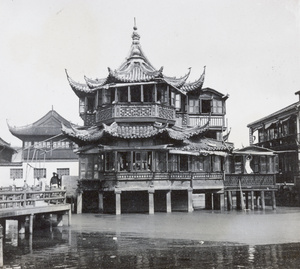Men with bird cages posed beside the Exquisite Jade Rock (玉玲珑), and a zigzag bridge, Yu Garden (豫园), Shanghai

Collection
Identifier
RA-m010
Notes
University of Bristol - Historical Photographs of China reference number: RA-m010. A scan of a magic lantern slide. Royal Asiatic Society Library reference: Glass Slide.00/(010). The large gongshi is the ‘Exquisite Jade Rock (玉玲珑)’ – see VH02-146 and https://avezink.livejournal.com/158668.html. The zig zag bridge is one of the bridges leading to Huxinting (湖心亭). The Huxinting tea house, dubbed 'The Willow Pattern Tea House' by foreigners due to its resemblance to a favourite English crockery design, is approached by a zigzag bridge (The Nine Curve Bridge). Huxinting may have been one of the inspirations for part of the imaginary scene depicted on willow-pattern crockery. This popular crockery design was developed by Thomas Turner in Shropshire, England in 1780. "South China is evidently the home of the story of the willow pattern which used to be so commonly painted on English china, for here the children's clothes, pinafores and ribbons are all embroidered with silk in this pattern." (Source: Kate Pruen 'The Provinces of Western China', 1906). See also Bk02-03, Bk03-04, Bk05-01, BL-s088, HR01-107, OH01-048, OH01-049, Pe01-048, VH02-133, VH02-144 and Wr-s100.
Caption in album or on mount
10 / Tea Garden
Location
Estimated Date
1870
Material
Other
Media
Black and white photograph
Repository
Royal Asiatic Society of Great Britain and Ireland

















